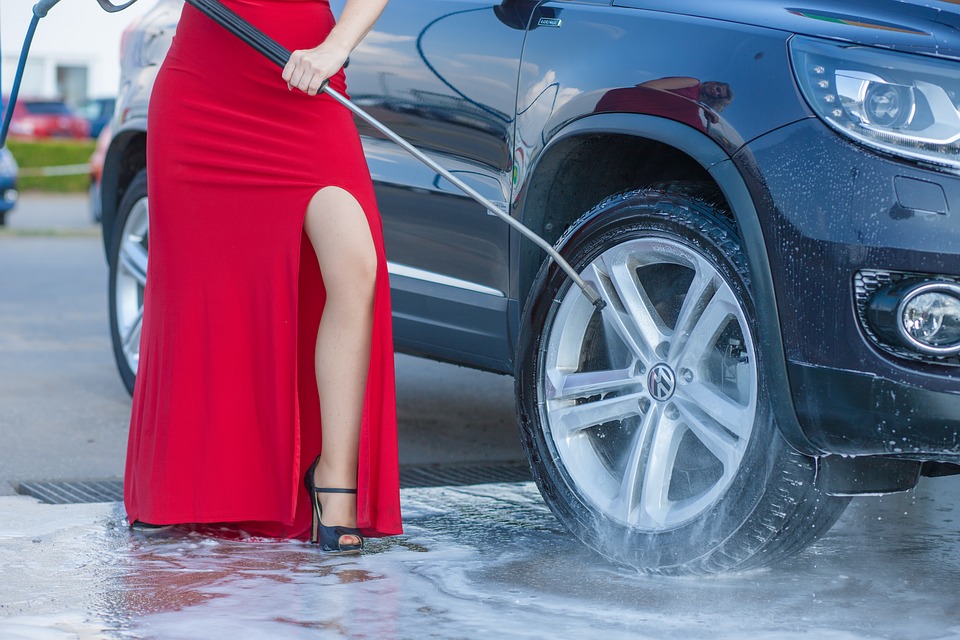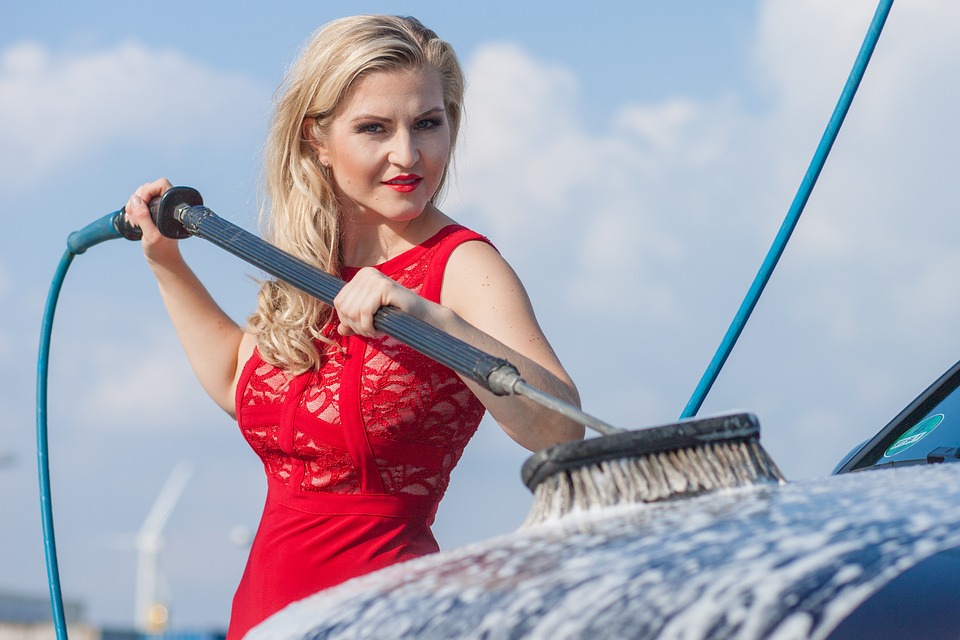How to Wash Your Car Inside and Outside Like a Pro

Here is the ultimate guide to cleaning your car.
I’ve put together the ultimate car valeting tips of the trade to help you look after your pride and joy.
Follow this ultimate guide and learn how to not only clean your car but also look after it once you have spent the time to get it into showroom condition.
I’ll share with you some great advice on how to keep your vehicle in tip-top showroom condition.
Good advice before you start
Ensure there is good drainage close to the area where you will be washing the vehicle.
Read the safety data on the label of any chemicals that you are about to use. Some chemicals require you to use them in a well-ventilated area.
Equip yourself with disposable gloves to protect your hands and wear suitable footwear to keep your feet dry.
Pay attention to the clothes that you are wearing. Chunky belt buckles can put a deep scratch in your paintwork. Zips, watch straps and metal buttons can also be a hazard.
Set out all of the equipment you intend to use. Having everything to hand makes the whole process a much easier chore.
Make sure vehicle windows are up and the doors are closed (that may sound obvious but you would be surprised)!
Check your paintwork before you start. Especially on older vehicles where the paintwork may be flaky or rusty.
Have you ever heard about the foam car washing system? Okay, this is a brand new concept in the market. This post will help you to know detail about foam wash: best foam gun for car wash.
Should I use a pre-wash

There are times, especially if you tend to cover a lot of miles between washes or if you tend to neglect your car for weeks at a time, that you should use a pre-wash first.
This chemical is more often referred to as traffic film remover and would generally be applied using a spray. The purpose of traffic film remover is to remove any of the oily residues that can be picked up from the roads or spray from other vehicles.
To use you should spray the entire vehicle and leave to soak for a few minutes. Longer for heavily soiled areas (always check the manufacturer’s directions for use).
For vehicles that are covered in flies, bugs and tar you should use a suitable chemical to spray the affected area. For more stubborn marks you should use a bug removing pad to gently scrub them away without damaging the paintwork (examples of these products are available as shown below).
Do not use on hot days and avoid letting it dry.
Remove the traffic film remover using a hose or power washer.
How do you wash?
There is no right or wrong way. It’s all down to personal choice.
Many people still tend to use the good old-fashioned bucket and sponge because it allows you to feel the dirt and see it close up.
Other people prefer to use a hose or a power washer.
Whatever the choice, you first need to remove any loose dirt from the vehicle. A hose is ideal for this. If using a power washer, ensure that the power isn’t set too high
Start at the top of the vehicle and work down using a side to side motion. pay and more attention to heavily soiled areas.
When hosing the wheels remember to spray under the wheel arches and mud flaps (if fitted) as lots of dirt tends to accumulate there.
A good quality car shampoo or pre-mixed wash & wax can now be applied to the entire car but avoid putting wash & wax directly onto the windshield. Using a sponge or brush apply liberally in circular movements until the whole bodywork is covered.
It’s good practice to use an old sponge to wash the tires and wheels. There are special brushes available that can be used on wheels allowing you to reach all of the deep crevices.
You can now rinse the shampoo using either a hose or a power washer, again starting at the top and working down the vehicle.
Don’t just leave the water
It’s always good practice to try to remove any surplus water from the bodywork before it dries and leaves streaks. On hot days move the vehicle into the shade if possible.
There is a vast array of squeegees on the market that are great for removing excess water. When buying a squeegee try to buy the best quality you can afford. Don’t purchase one with any metal parts as these may damage the paintwork.
Most squeegees have a plastic handle and soft rubber blade. If possible get two sizes. A large one is ideal for general use but a small one always comes in handy for the harder to reach areas.
When using, do not apply to much pressure. You are lightly removing water NOT stripping paint.
Real or artificial leather?
Your next job is to dry the vehicle and remove any water marks left by the squeegee.
This can be done using either a synthetic or a real leather chamois.
My own personal choice that gets results is to use a synthetic chamois leather to start.
Fill your bucket with clean warm water and soak the chamois well. Wring it out to remove excess water then wipe the entire vehicle starting at the top again using circular movements.
Once done you can then repeat the process using a real leather chamois. The real leather helps give a streak-free, deep shine to the bodywork.
Drying tips
Now that you have ‘leathered’ the vehicle you need to make sure all of the hard to see places are dry.
Open all of the car doors to get some air to the door seals.
Using your chamois leather wipe all of the visible areas in and around the door sills, hinges etc. Don’t forget the bottom edge of the doors as any excess water will fall to the lowest point.
Lower the windows slightly so that you can wipe the top edge of all of the windows. While the doors are open you can take this opportunity to use your chamois and wipe the inside of all of the windows including the windshield.
Don’t be afraid to use an electric hair dryer to help dry those very hard to reach areas (but be careful, if there’s still water lying around).
If you have a wet and dry vacuum cleaner with a small nozzle attachment, then these are great for removing water from difficult to reach areas such as behind the door mirrors.

Are there any more great tips that you would like to share with us?
The answer is yes. I do have many cool tips
Mirrors and glass top tips
Do not use any rubber or vinyl protecting chemicals directly on the windshield wiper blades as it may impair their effectiveness in the rain.
If wiper blades judder across the windshield get some extremely fine wire wool and rub some glass cleaner over the entire windshield. DO NOT APPLY MUCH PRESSURE as you may scratch the glass. To finish, wipe clean and apply glass cleaner liberally before polishing off with a soft dry cloth.
As a glass cleaning alternative. Take a piece of scrunched up newspaper and rub in a mixture of vinegar and water. This will also give the glass an extra shine.
When cleaning the rear window, all movements should be in the direction of the heated elements to avoid snagging of tearing.
Body and paintwork top tips.
Never use a yellow duster to polish your car. They are made of synthetics and can scratch easily. If the car is still damp the yellow dye in the cloth may stain the paintwork.
Only use high quality cotton clothes or microfiber cloths for polishing. Using old clothes may seem like a cheap alternative but could be quite abrasive if the fibers are manmade.
If the area you live is known for having hard water, wash your car in small areas then dry it before moving onto the next e.g. roof first, then the hood, then each door etc.
Do not use a steam cleaner on paintwork. If there is a stone chip that you haven’t noticed, the steam could get under the paint and cause it to blister.
Never use a power washer or steam cleaner on the engine. Modern cars have so much computerized technology under the hood, any fluid or steam contact could cause immense damage.
